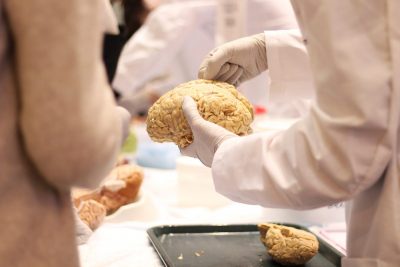
Researchers at Boston University’s Chronic Traumatic Encephalopathy Center released a study Tuesday that found that 177 of 202 former football players’ brains linked repetitive head impact with the brain disease CTE.
The study sought to improve the understanding of the relationship between repetitive head impact and the development of the neurodegenerative disease, said co-lead author Daniel Daneshvar. Most common among athletes, military veterans and those with a history of brain trauma, CTE develops proteins that spread throughout the brain and kill brain cells, according to the Concussion Legacy Foundation.
“What we’ve done here is report the largest, most methodologically rigorous group of individuals with CTE ever,” Daneshvar, a researcher in the CTE department of BU’s School of Medicine, said. “These are all individuals who experienced the same type of exposure to repetitive brain trauma that was from football.”
The study, published in the Journal of the American Medical Association, was a collaboration between the BU CTE Center, the VA Boston Healthcare System and the CLF, Daneshvar said. The CTE Center and Boston VA carried out the research while the CLF coordinated athletes’ brain donations.
Data showed that CTE’s presence and severity increased along with the level of play, upward from high school to college to the National Football League. In the sample, the neurodegenerative brain disease affected three of 14 high school players, 48 of 53 college players, nine of 14 semiprofessional players and 110 of 111 NFL players, according to the study.
Daneshvar added that the study effectively doubled the number of cases of CTE reported in world literature, where it was first described nearly 90 years ago.
Although the results may seem startling, Daneshvar said it is important to note the nature of brain donation to the brain bank. The study used a convenience sample of brains that were voluntarily donated by players and families, leading to a “necessarily biased sample.”
“We didn’t go out into the community and randomly get people to donate their brain tissue to us,” Daneshvar said. “I’m quite sure that if you think you might have problems yourself with memory or behavior or mood, or if your loved ones think that you might’ve had issues with those domains, you’re more likely to seek out a research center to donate your tissue to.”
That being said, it’s harder to doubt the relationship between repetitive brain trauma and CTE with such a high proportion of brains studied having CTE, he added.
BU neurology professor Andrew Budson said, as a clinician, he thinks the study carries a lot of weight.
“One of the things that [the study] highlights to me as someone who sees patients with memory disorders clinically is that my patients may have more than one diagnosis,” he said. “One important broad implication for physicians is to keep in mind is that people may have more than one neurodegenerative diagnosis.”
Budson added that he hopes society will come to terms with the study’s results and take them into consideration.
“We need to think as a society about football and the risk of getting CTE,” he said. “At the very least, I think it’s important that individuals understand the risks that are inherent in the sport.”
Although the study has concluded, Daneshvar said the data raised questions the CTE Center will look forward to answering.
“Now we can move on to start answering the serious questions, like what types of hits to the head are responsible for the development of CTE, whether there are certain other risk factors — like genetic or environmental factors — that might predispose someone to risk CTE,” he said.
Additionally, since posthumous brain donation is currently the only method of diagnosing CTE, Daneshvar said the next step is to figure out how to diagnose CTE in people who are still alive.
“What we’re hoping to do is take this group of individuals who generously donated their brains to research and from them, get all the information we can,” he said, “so we can apply it to individuals who are struggling with this disease or who are at risk of developing it.”
Campus News Editor Fall '17




